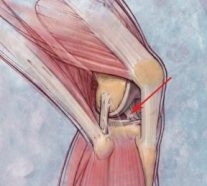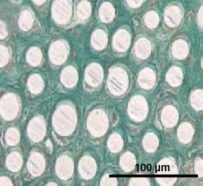A fix for injured knees
A new way of repairing a common knee injury might someday help athletes recover faster.
Being a professional athlete must be a lot of fun. But it’s also risky. Just ask New England Patriots receiver Chad Jackson. He recently injured his knee during a game against the Superbowl-winning Indianapolis Colts. Jackson faces surgery, and he won’t be able to play for a while.
Knee injuries are common in sports because people’s knees are actually rather fragile. Only a few tight bands, called ligaments, hold your leg bone to your thigh bone. When you play sports, the ligaments are the only things that keep your knees from bending sideways or backward! Torn ligaments are among the most common kinds of athletic knee injuries.
 |
|
Athletes sometimes tear an important band of knee tissue called the ACL (arrow).
|
| Artville |
If an athlete tears a knee ligament, doctors have to do surgery to repair it. Most often, the ligament that tears is the ACL, which stands for “anterior cruciate ligament.” A torn ACL doesn’t heal like your skin does. So, surgeons must replace the injured ACL with a piece of healthy ligament that they remove from another spot in the patient’s leg. It takes a long time to recover from this surgery. It’s painful too.
Cato T. Laurencin and other scientists at the University of Virginia in Charlottesville are working on a new way to repair knee ligaments. They want to make a fake ligament that surgeons can use instead of a real one. They’ve already created such a ligament by putting artificial materials together with cells from rabbits. When they tested the artificial ligament in rabbits, the cells slowly grew and created a new, natural ligament, while the artificial materials dissolved little by little.
 |
|
A microscope shows that cells (purple) and other important tissue (green) are growing in the spaces between bits of an artificial knee ligament (white).
|
| Proceedings of the National Academy of Sciences |
So far, the researchers have tried this new idea only on rabbits. But someday, their research might help injured athletes such as Jackson get back in the game sooner.—P. Barry
Going Deeper:
Barry, Patrick. 2007. Hurt-knees Rx: Surgical method promotes ligament regeneration. Science News 171(Feb. 24):116. Available at http://www.sciencenews.org/articles/20070224/fob3.asp .
Sohn, Emily. 2005. Football scrapes and nasty infections. Science News for Kids (Feb. 9). Available at http://www.sciencenewsforkids.org/articles/20050209/Note2.asp .
______. 2004. Workouts: Does stretching help? Science News for Kids (May 5). Available at http://www.sciencenewsforkids.org/articles/20040505/Feature1.asp .
______. 2003. A framework for growing bone. Science News for Kids (April 30). Available at http://www.sciencenewsforkids.org/articles/20030430/Note3.asp .
______. 2003. Prime time for broken bones. Science News for Kids (Oct. 8). Available at http://www.sciencenewsforkids.org/articles/20031008/Note3.asp .







